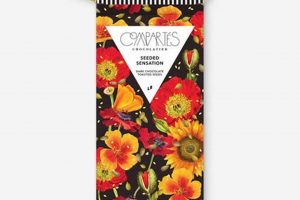A smooth, rich mixture typically made with chocolate and cream finds a plant-based adaptation. This variation uses ingredients such as coconut cream, oat cream, or other non-dairy alternatives in place of traditional dairy cream. Its consistency and flavor profile are remarkably similar to its conventional counterpart, offering a decadent experience suitable for individuals adhering to vegan dietary principles.
The significance of this preparation lies in its accessibility, allowing individuals with dietary restrictions to enjoy a classic confection. It broadens the appeal of chocolate-based desserts and pastries, providing a delicious option that aligns with ethical and health-conscious preferences. Historically, the development of vegan alternatives has been driven by a growing awareness of animal welfare and the increasing prevalence of lactose intolerance and dairy allergies.
The following sections will delve into specific recipes, ingredient considerations, troubleshooting techniques, and applications for this plant-based dessert component, providing a comprehensive guide to its creation and use.
Tips for Optimal Results
Achieving a desirable consistency and flavor profile requires attention to detail and adherence to proven techniques.
Tip 1: Select High-Quality Chocolate: The flavor of the chocolate directly impacts the final product. Opt for chocolate with a cocoa content between 55% and 70% for a balanced richness and depth of flavor.
Tip 2: Choose the Appropriate Non-Dairy Cream: Coconut cream yields a rich, decadent texture, while oat cream provides a lighter, more neutral base. The selection influences the overall flavor and consistency.
Tip 3: Accurately Measure Ingredients: Precise measurements are crucial for achieving the correct ratio of chocolate to cream. Utilize a kitchen scale for accurate ingredient quantities.
Tip 4: Control the Temperature: Heat the non-dairy cream gently, avoiding boiling. Overheating can affect the texture and stability of the mixture.
Tip 5: Emulsify Thoroughly: Ensure the melted chocolate and warmed cream are fully emulsified. Use an immersion blender or whisk vigorously to achieve a smooth, homogenous mixture. Gradual addition of the cream to the chocolate also aids in emulsification.
Tip 6: Allow Adequate Setting Time: Refrigerate the mixture for a minimum of two hours, or preferably overnight, to allow it to fully set and develop its desired consistency.
Tip 7: Adjust Sweetness as Needed: Depending on the chocolate used, the mixture may require additional sweetener, such as maple syrup or agave nectar. Add sweetener gradually and taste frequently until the desired sweetness level is achieved.
Tip 8: Consider Flavor Enhancements: Extracts, such as vanilla or peppermint, can be incorporated to complement the chocolate flavor. Add these in small quantities during the emulsification process.
By diligently following these guidelines, consistent results and optimal flavor profiles can be readily achieved. Careful attention to ingredient quality, measurement accuracy, temperature control, and emulsification techniques contribute to the success of this plant-based dessert component.
The subsequent sections will address potential troubleshooting scenarios and offer solutions for common challenges encountered during preparation.
1. Ingredient Substitution
Ingredient substitution constitutes the foundational element in the creation of chocolate ganache vegan. The absence of dairy, a defining characteristic of traditional ganache, necessitates the strategic replacement of cream with plant-based alternatives. The choice of substitute directly impacts the final products texture, stability, and flavor profile. For instance, substituting coconut cream, with its higher fat content, yields a rich and decadent mouthfeel closely resembling traditional ganache. Alternatively, oat cream, with its lower fat content, results in a lighter and less intense flavor. Thus, the success of this preparation hinges on the informed selection and utilization of appropriate replacements.
The practical application of ingredient substitution extends beyond mere replacement; it involves understanding the functional properties of each substitute. For instance, some non-dairy milks may require the addition of a stabilizer, such as cornstarch or agar-agar, to achieve the desired viscosity. The fat content of the chosen chocolate also plays a crucial role. Dark chocolate with a higher cocoa butter content interacts differently with plant-based creams compared to milk chocolate. Careful consideration of these interactions is essential for achieving the optimal emulsion and preventing separation or a grainy texture. A real-world example includes bakers using silken tofu, although unusual, to achieve extreme creaminess and bind the emulsion together for a specific application.
In summary, the careful application of ingredient substitution forms the backbone of the plant-based derivative. Selection choices of non-dairy alternatives are critical for the outcome, ensuring the texture, stability, and flavor profile is close to its non-vegan origin. Challenges may arise from the varying properties of substitute ingredients, requiring adjustments to the recipe and technique. The broader theme emphasizes the adaptability of classic recipes to accommodate dietary restrictions and ethical considerations, while retaining the desired culinary qualities.
2. Texture Modification
Texture modification constitutes a critical aspect in the successful creation of chocolate ganache vegan. The texture, ranging from a smooth, velvety consistency to a firm, spreadable one, significantly impacts the final perception and application of the product. In the context of plant-based adaptations, the inherent properties of non-dairy cream substitutes necessitate precise manipulation to replicate the texture of traditional dairy-based ganache. The ratio of chocolate to non-dairy cream is the primary factor influencing texture; a higher proportion of chocolate results in a firmer ganache, while a higher proportion of cream yields a softer consistency. However, the specific type of non-dairy cream employed also plays a crucial role. For example, coconut cream, due to its higher fat content, tends to produce a richer and denser texture compared to almond or oat cream. Stabilizers, such as cornstarch or agar-agar, can be incorporated to further adjust the texture, particularly in formulations using lower-fat alternatives.
Beyond the selection of ingredients and their ratios, the preparation technique profoundly affects the final texture. Overheating the non-dairy cream can lead to separation or a grainy consistency. Conversely, insufficient heating may result in incomplete emulsification, yielding a lumpy or uneven texture. Thorough emulsification, achieved through consistent stirring or the use of an immersion blender, is essential for creating a smooth, homogenous mixture. Refrigeration time and temperature also influence the setting process and ultimate texture of the finished product. Longer chilling times generally result in a firmer ganache, while higher refrigeration temperatures may slow down the setting process or lead to the formation of ice crystals. As an example, a professional pastry chef may use a specific brand of dark chocolate known for its high cocoa butter content in conjunction with full-fat coconut cream to achieve a particularly glossy and smooth ganache for glazing a vegan entremet.
In summary, texture modification represents a multifaceted process integral to crafting a satisfactory chocolate ganache vegan. The successful achievement of a desired texture hinges on careful ingredient selection, precise ratio control, meticulous preparation techniques, and controlled setting conditions. Challenges may arise from the inherent variability in non-dairy cream substitutes, requiring adaptive adjustments to the formulation and process. The ability to effectively modify texture expands the versatility of chocolate ganache vegan, enabling its application across a wide range of culinary creations. This understanding underscores the importance of a systematic and informed approach to vegan baking and confectionery.
3. Flavor Enhancement
Flavor enhancement plays a crucial role in elevating the sensory experience of chocolate ganache vegan. The absence of dairy fats necessitates strategic interventions to achieve a comparable richness and complexity to traditional ganache. Flavor enhancement techniques are not merely additive, but rather integral to balancing the inherent characteristics of plant-based ingredients and amplifying the chocolate notes.
- Vanilla Extract Integration
Vanilla extract, a ubiquitous flavor enhancer, functions by complementing the inherent sweetness and bitterness of chocolate. Its subtle floral and creamy notes mitigate any perceived lack of richness often associated with dairy-free preparations. In the context of chocolate ganache vegan, a high-quality vanilla extract can bridge the sensory gap between the traditional and plant-based versions, enhancing the overall palatability.
- Coffee Infusion
Coffee, either in the form of espresso or finely ground beans, can be infused into the non-dairy cream before combining it with chocolate. The robust and slightly bitter notes of coffee intensify the chocolate flavor, creating a more complex and sophisticated profile. This technique is particularly effective in dark chocolate ganache, where the inherent bitterness of both ingredients synergizes to create a deeply satisfying taste experience. For example, adding a teaspoon of instant espresso powder to coconut cream before melting with dark chocolate improves the flavour depth.
- Salt Incorporation
A small amount of salt, such as sea salt or kosher salt, serves to balance the sweetness and enhance the perceived intensity of the chocolate. Salt acts as a flavor potentiator, suppressing bitterness and accentuating desirable flavor compounds. In chocolate ganache vegan, a judicious pinch of salt can elevate the overall flavor profile, making the chocolate taste richer and more nuanced. An example of this is adding a pinch of fleur de sel to the finished product to round it off.
- Citrus Zest Addition
Citrus zest, particularly orange or lemon, introduces bright, aromatic notes that complement the richness of chocolate. The volatile oils present in citrus zest provide a refreshing counterpoint to the deep, intense flavor of chocolate, creating a more balanced and complex flavor profile. This technique is particularly effective in ganache intended for use in desserts with a fruity or acidic component. For example, grating fresh orange zest into the heated plant-based cream prior to combining it with chocolate adds a distinctive and refreshing aroma to the ganache.
These diverse flavor enhancement strategies illustrate the versatility of chocolate ganache vegan. By carefully selecting and integrating complementary flavors, it is possible to create a plant-based ganache that rivals its traditional counterpart in terms of richness, complexity, and overall palatability. These techniques also allows for the creation of more creative and nuanced desserts. Through innovative flavor pairings and strategic use of enhancers, the potential of this vegan confection can be fully realized.
4. Application Versatility
The adaptability of chocolate ganache vegan expands its utility across a wide spectrum of culinary applications. This versatility stems from its adjustable consistency, flavor profile, and stability, making it a valuable component in both professional pastry settings and home kitchens.
- Cake and Cupcake Frosting
As a frosting, chocolate ganache vegan provides a smooth, rich coating for cakes and cupcakes. Its consistency can be adjusted by varying the ratio of chocolate to non-dairy cream. A higher chocolate ratio results in a firmer frosting suitable for sculpted designs, while a higher cream ratio produces a softer, more spreadable texture. The flavor can be further enhanced with extracts or liqueurs to complement the underlying cake flavor. Its dairy-free nature also broadens appeal for consumers with dietary restrictions. Professional bakers may opt for this as a way to provide a product that appeals to a wider customer base.
- Truffle Creation
Refrigerated and rolled into balls, chocolate ganache vegan forms the base for decadent truffles. The firm consistency achieved after chilling allows for easy shaping and coating in cocoa powder, chopped nuts, or melted chocolate. Its richness and smooth texture contribute to the luxurious mouthfeel of truffles, offering a plant-based alternative to traditional dairy-based recipes. Chocolatiers often choose non-dairy ganache to allow for additional flavor infusion without extra fat.
- Glazing and Sauce Applications
When warmed, this ganache can be used as a glaze for pastries or a sauce for desserts. Its smooth, glossy finish enhances the visual appeal of cakes, tarts, and other confections. The flavor can be adjusted with spices or extracts to create a customized sauce that complements the main dish. In this form, the sauce can be ladled, piped, or dripped, depending on needs.
- Filling for Pastries and Chocolates
Its adaptability makes it an excellent filling for pastries like clairs, cream puffs, and tarts. When enrobing the filling into chocolates, the texture can be adjusted to be more firm, or more fluid for easy pouring. Its rich flavor and smooth texture add a layer of indulgence to these desserts. A plant-based ganache provides a dairy-free filling option for customers seeking alternatives to traditional pastry fillings. Some pastry chefs will even introduce a small percentage of nut butter for extra mouth feel.
The aforementioned applications showcase the diverse possibilities of chocolate ganache vegan. Its adaptability extends beyond these examples, allowing for creative experimentation and customized formulations to suit various culinary needs. This versatility reinforces its value as a staple ingredient in both professional and home kitchens seeking plant-based alternatives without compromising on flavor or texture.
5. Shelf Life
The shelf life of chocolate ganache vegan is a critical consideration for both commercial producers and home cooks. Several factors influence its longevity, impacting product quality and safety. Understanding these factors is essential for proper storage and utilization of this plant-based confection.
- Ingredient Selection and Quality
The choice of non-dairy cream significantly affects the shelf life. Coconut cream, due to its higher fat content, may exhibit greater stability compared to lower-fat alternatives like oat milk. The quality of chocolate used also plays a role; higher-quality chocolate with a stable cocoa butter content tends to resist bloom (the formation of white streaks) and maintain its texture for a longer period. Commercially produced coconut creams may contain stabilizers and preservatives that extend shelf life, however, homemade creams are more prone to spoiling.
- Storage Conditions
Proper storage is paramount for maximizing the shelf life of chocolate ganache vegan. Refrigeration is essential to inhibit microbial growth and maintain its consistency. The ganache should be stored in an airtight container to prevent moisture absorption and odor contamination. Fluctuations in temperature can accelerate spoilage, so maintaining a consistent refrigerator temperature is crucial. Room temperature will cause the product to soften, and eventually spoil.
- Sanitation Practices
Sanitation during preparation significantly impacts the shelf life. Utilizing clean equipment and utensils minimizes the introduction of microorganisms that can lead to spoilage. Proper handwashing and adherence to food safety guidelines are essential. Commercial kitchens often employ strict sanitation protocols to ensure product safety and extend shelf life. It’s also important to avoid cross-contamination.
- Presence of Stabilizers and Preservatives
Commercial formulations may include stabilizers and preservatives to extend the shelf life of chocolate ganache vegan. Stabilizers, such as lecithin or guar gum, prevent separation and maintain a smooth texture. Preservatives, such as potassium sorbate or sodium benzoate, inhibit microbial growth. While these additives can prolong shelf life, they may also affect the taste and texture of the ganache. While these additives are regulated in most places, some prefer a shorter shelf life over including synthetic stabilizers.
These considerations highlight the multifaceted nature of shelf life determination for chocolate ganache vegan. Attention to ingredient quality, storage conditions, sanitation practices, and the potential use of stabilizers and preservatives are all crucial for ensuring a safe and palatable product. Careful management of these factors allows for the creation and enjoyment of this plant-based dessert component over an extended period.
Frequently Asked Questions
This section addresses common inquiries and provides clarification regarding the preparation, properties, and applications of this specific plant-based dessert component.
Question 1: Can chocolate ganache vegan achieve the same texture and consistency as traditional dairy-based ganache?
Achieving a comparable texture is attainable through careful ingredient selection and precise ratios. The type of non-dairy cream utilized significantly influences the final consistency. Coconut cream, with its higher fat content, yields a richer texture, while alternatives may require stabilizers to replicate the desired smoothness.
Question 2: What are the most suitable non-dairy cream alternatives for preparing chocolate ganache vegan?
Coconut cream, oat cream, and cashew cream are frequently employed. Coconut cream provides richness, oat cream offers a neutral flavor, and cashew cream requires blending for smoothness. The choice depends on the desired flavor profile and texture.
Question 3: Does the type of chocolate used impact the flavor of chocolate ganache vegan?
Indeed. The cocoa content and quality of the chocolate directly influence the final flavor. Opt for chocolate with a cocoa content between 55% and 70% for a balanced flavor profile. High-quality chocolate contributes to a richer, more complex taste.
Question 4: How long can chocolate ganache vegan be stored, and what are the optimal storage conditions?
When stored in an airtight container in the refrigerator, chocolate ganache vegan typically maintains its quality for up to five days. Proper refrigeration inhibits microbial growth and preserves its texture and flavor.
Question 5: Are there any common challenges encountered during the preparation of chocolate ganache vegan, and how can they be addressed?
Common challenges include separation, graininess, and improper setting. Separation can be mitigated by thoroughly emulsifying the mixture and avoiding overheating. Graininess may result from using low-quality chocolate or improper emulsification. Insufficient setting can be resolved by refrigerating the mixture for a longer period or adjusting the ratio of chocolate to cream.
Question 6: Can flavor extracts or other additions be incorporated into chocolate ganache vegan?
Yes. Extracts such as vanilla, peppermint, or orange, and spices like cinnamon or nutmeg can enhance the flavor. These additions should be incorporated during the emulsification process to ensure even distribution and integration of flavors.
These inquiries and responses provide a foundational understanding of chocolate ganache vegan. Successful preparation relies on attention to detail, quality ingredients, and proper techniques.
The next section will present specific recipes and variations for creating chocolate ganache vegan.
Conclusion
This exploration has delineated the components, preparation, applications, and preservation of chocolate ganache vegan. From ingredient substitution to flavor enhancement and shelf-life considerations, the details provided serve to establish a foundational understanding of this plant-based confection. Precise execution of techniques is crucial for achieving results comparable to traditional dairy-based counterparts.
The increasing demand for plant-based alternatives necessitates continued refinement and innovation in culinary techniques. Further research and experimentation will undoubtedly expand the possibilities for chocolate ganache vegan, solidifying its place in both professional and home kitchens. The information presented is intended to inform conscientious application of technique and ingredients to achieve maximum consistency and flavor potential.







